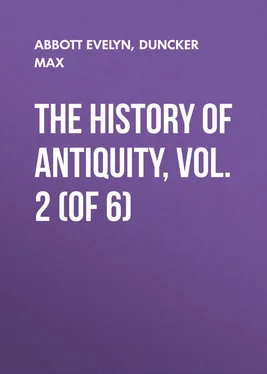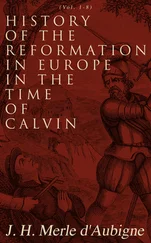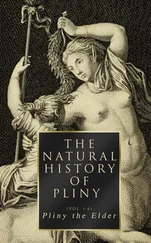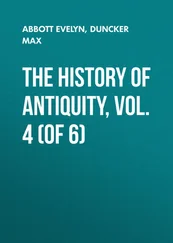Evelyn Abbott - The History of Antiquity, Vol. 2 (of 6)
Здесь есть возможность читать онлайн «Evelyn Abbott - The History of Antiquity, Vol. 2 (of 6)» — ознакомительный отрывок электронной книги совершенно бесплатно, а после прочтения отрывка купить полную версию. В некоторых случаях можно слушать аудио, скачать через торрент в формате fb2 и присутствует краткое содержание. Жанр: foreign_antique, foreign_prose, Историческая проза, на английском языке. Описание произведения, (предисловие) а так же отзывы посетителей доступны на портале библиотеки ЛибКат.
- Название:The History of Antiquity, Vol. 2 (of 6)
- Автор:
- Жанр:
- Год:неизвестен
- ISBN:нет данных
- Рейтинг книги:4 / 5. Голосов: 1
-
Избранное:Добавить в избранное
- Отзывы:
-
Ваша оценка:
- 80
- 1
- 2
- 3
- 4
- 5
The History of Antiquity, Vol. 2 (of 6): краткое содержание, описание и аннотация
Предлагаем к чтению аннотацию, описание, краткое содержание или предисловие (зависит от того, что написал сам автор книги «The History of Antiquity, Vol. 2 (of 6)»). Если вы не нашли необходимую информацию о книге — напишите в комментариях, мы постараемся отыскать её.
The History of Antiquity, Vol. 2 (of 6) — читать онлайн ознакомительный отрывок
Ниже представлен текст книги, разбитый по страницам. Система сохранения места последней прочитанной страницы, позволяет с удобством читать онлайн бесплатно книгу «The History of Antiquity, Vol. 2 (of 6)», без необходимости каждый раз заново искать на чём Вы остановились. Поставьте закладку, и сможете в любой момент перейти на страницу, на которой закончили чтение.
Интервал:
Закладка:
After this, for the space of more than 100 years (1040-930), there is again a gap in our knowledge. Not till we reach Assur-dayan II., who ascended the throne of Assyria about the year 930 B.C., can we again follow the series of the Assyrian kings downwards without interruption. This Assur-dayan II. is followed by Bin-nirar II., about 900; Bin-nirar, by Tiglath Adar II., who reigned from 889-883 B.C. He had to contend once more against the land of Nairi, i. e. against the region between the Eastern Tigris and the upper course of the Upper Zab. As a memorial of the successes which he gained here he caused his image to be carved beside that of Tiglath Pilesar in the rocks at Karkar (see below). Besides this, there is in existence from his time a pass, i. e. a small tablet, with the inscription, "Permission to enter into the palace of Tiglath Adar, king of the land of Asshur, son of Bin-nirar, king of the land of Asshur." 61 61 Ménant, "Annal." p. 63.
Neither at the commencement nor in the course of the history of Assyria do the monuments know of a king Ninus, a queen Semiramis, or of any warlike queen of this kingdom; they do not even mention any woman as standing independently at the head of Assyria. Once, it is true, we find the name Semiramis in the inscriptions in the form Sammuramat. Sammuramat was the wife of king Bin-nirar III., who ruled over Assyria from the year 810-781 B.C. On the pedestal of two statues, which an officer of this king, the prefect of Chalah, dedicated to the god Nebo, the inscription is: "To Nebo, the highest lord of his lords, the protector of Bin-nirar, king of Asshur, and protector of Sammuramat, the wife of the palace, his lady." The name of Ninyas is quite unknown to the monuments, and of the names of the 33 kings which Ctesias gives, with their names and reigns as successors of Ninyas down to the overthrow of the kingdom and Sardanapalus (p. 26), – unless we identify the last name in the list, that of Sardanapalus, with the Assurbanipal of the inscriptions, i. e. with the ruler last but one or two according to the records, – no single one agrees with the names of the monuments, which, moreover, give a higher total than six-and-thirty for the reigns of the Assyrian kings. The list of Ctesias appears to have been put together capriciously or merely invented; the lengths of the reigns are pure imagination, and arranged according to certain synchronisms.
Not less definite is the evidence of the monuments that the pre-eminence of Assyria over Upper Asia cannot have commenced in the year 2189 or 1913 B.C., as Ctesias asserts, or as may be assumed from his data, nor in 1273, as has been deduced from the statements of Berosus, nor finally in the year 1234, according to Herodotus' statements (p. 27). Though we are able to find only approximately the dates of the kings of Assyria, whose names and deeds we have passed in review, the result is, nevertheless, that the power of Assyria in the fifteenth and fourteenth centuries did not go far beyond the native country – that her forces by no means surpassed those of Babylon – that precisely in the thirteenth and twelfth centuries B.C. the kingdom of Babylon was at least as strong as that of Assyria – that even towards the close of the twelfth century Tiglath Pilesar I. could gain no success against Babylon – that his successors sought to establish peaceful relations with Babylonia. There is just as little reason to maintain the period of 520 years which Herodotus allows for the Assyrian empire over Asia. This cannot in any case be assumed earlier than the date of Tiglath Pilesar I., who did at least cross the Euphrates and enter Northern Syria. The beginning of this empire would, therefore, be about 1130 B.C., not 1234 B.C. The date also which Herodotus gives for the close of this empire (before 700 B.C.) cannot, as will be shown, be maintained. According to this datum the decline and fall of Assyria must have began with the period in which, as a fact, she rose to the proudest height and extended her power to the widest extent. The period of 520 years can only be kept artificially by reckoning it upwards from the year 607 B.C., the year of the overthrow of the Assyrian empire; then it brings us from this date to 1127 B.C., i. e. to the time of Tiglath Pilesar I. But we saw that the conquests of Tiglath Pilesar did not extend very far, that his successes west of the Euphrates were of a transitory nature; in no case could a dominion of Assyria over Babylon be dated from his reign.
The complete agreement of the Assyrian and Babylonian style and civilisation is proved most clearly by the monuments. The names of the princes of Assyria are formed analogously to those of the Babylonians; the names and the nature of the deities which the Assyrians and Babylonians worship are the same. In Assyria we meet again with Anu the god of the high heaven, Samas the sun-god, Sin the moon-god, Bin (Ramman) the god of the thunder; of the spirits of the planets Adar, the lord of Saturn, Nebo, the god of Mercury, and Istar, the lady of Venus, in her double nature of destroyer and giver of fruit, reappear. There is only one striking difference: the special protector of Assyria, Asshur, the god of the land, stands at the head of the gods in the place of El of the Babylonians. He it is after whom the land and the oldest metropolis is named, whose representatives the oldest princes of Assyria appear to have called themselves. The name of Asshur is said to mean the good or the kind; 62 62 E. Schrader, "Keilinschriften und A. T." s. 7.
which may even on the Euphrates have been an epithet of El, which on the Tigris became the chief name of the deity. As the ancient princes of Ur and Erech, of Nipur and Senkereh, as the kings of Babel – so also the kings of Assyria, as far back as our monuments allow us to go – built temples to their gods; like them they mark the tiles of their buildings with their names; like the kings of Babel, they cause inscriptions to be written on cylinders, intended to preserve the memory of their buildings and achievements, and then placed in the masonry of their temples. The language of the inscriptions of Assyria differs from those of the Babylonian inscriptions, as one dialect from another; the system of writing is the same. The population of Assyria transferred their language and writing, their religious conceptions and modes of worship, from the Lower Euphrates to the Upper Tigris. If the princes of Erech, Nipur and Babylon had to repel the attacks of Elam, the Assyrian land, a region of moderate extent, lay under the spurs of the Armenian table-land, under the ranges of the Zagrus. The struggle against the tribes of these mountains, in the Zagrus and in the region of the sources of the Euphrates and the Tigris, and the stubborn resistance of these tribes appears to have strengthened the warlike powers of the Assyrians, and these ceaseless campaigns trained them to that military excellence which finally, after a period of exercise which lasted for centuries, won for them the preponderance over Mesopotamia and Syria, over Babylonia and Elam, no less than over Egypt.
CHAPTER III
THE NAVIGATION AND COLONIES OF THE PHENICIANS
At the time when Babylonia, on the banks of the Euphrates, flourished under the successors of Hammurabi in an ancient and peculiar civilisation, and Assyria was struggling upwards beside Babylonia on the banks of the Tigris, strengthening her military power in the Armenian mountains and the ranges of the Zagrus, and already beginning to try her strength in more distant campaigns, a Semitic tribe succeeded in rising into eminence in the West also, in winning and exerting a deep-reaching influence on distant and extensive lands. It was a district of the most moderate extent from which this influence proceeded, its dominion was of a different kind from that of the Babylonians and Assyrians; it grew up on an element which elsewhere appeared not a favourite with the Semites, and sought its points of support in settlements on distant islands and coasts. By this tribe the sea was actively traversed and with ever-increasing boldness; by circumspection, by skill, by tough endurance and brave ventures it succeeded in extending its dominion in ever-widening circles, and making the sea the instrument of its wealth and the bearer of its power.
Читать дальшеИнтервал:
Закладка:
Похожие книги на «The History of Antiquity, Vol. 2 (of 6)»
Представляем Вашему вниманию похожие книги на «The History of Antiquity, Vol. 2 (of 6)» списком для выбора. Мы отобрали схожую по названию и смыслу литературу в надежде предоставить читателям больше вариантов отыскать новые, интересные, ещё непрочитанные произведения.
Обсуждение, отзывы о книге «The History of Antiquity, Vol. 2 (of 6)» и просто собственные мнения читателей. Оставьте ваши комментарии, напишите, что Вы думаете о произведении, его смысле или главных героях. Укажите что конкретно понравилось, а что нет, и почему Вы так считаете.












